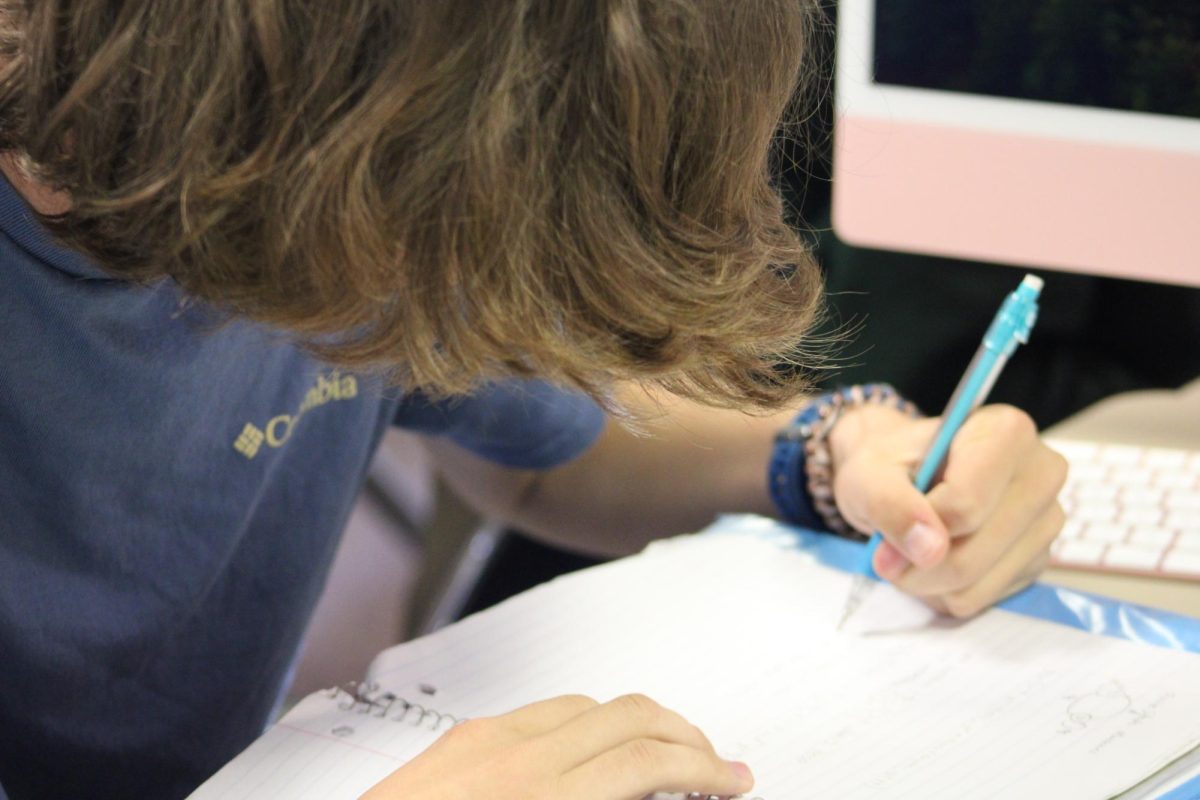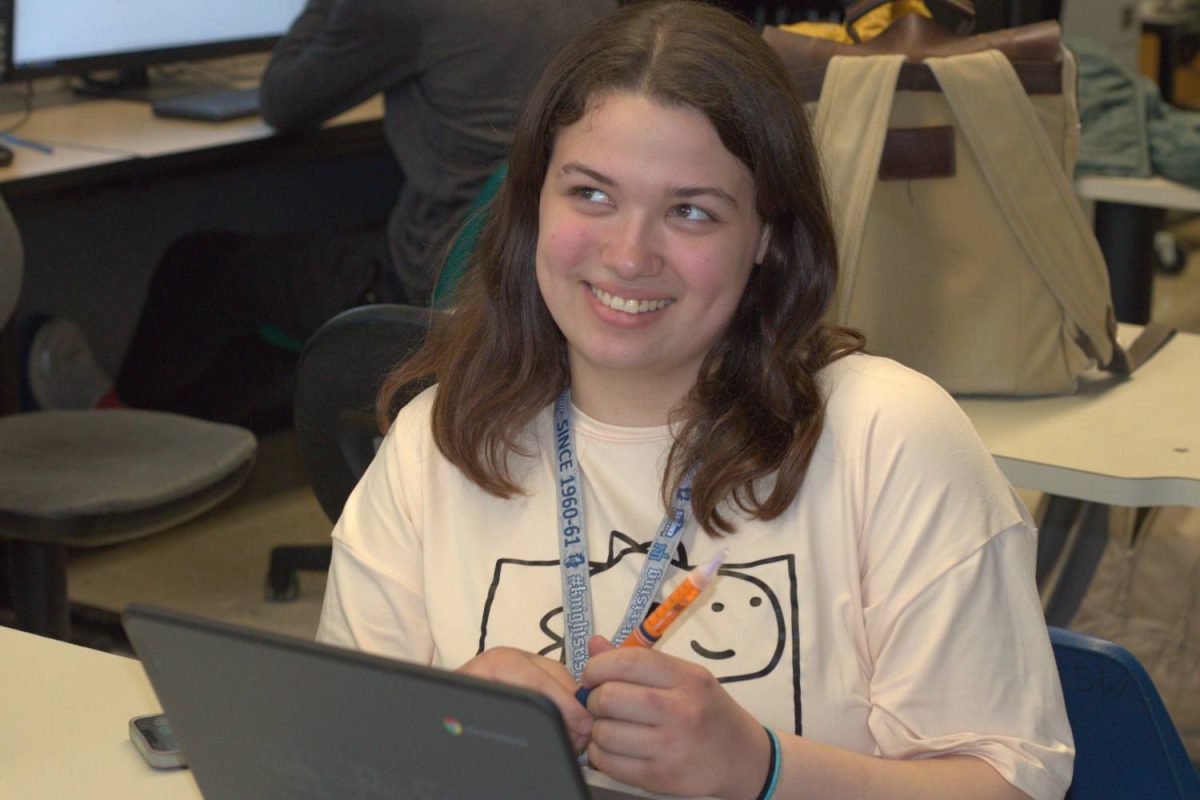The typical student at Loy Norrix stays in the building all day, taking standard classes and interacting only with the students at the school.
However, this isn’t the case for sophomore Dominic Abate. Abate drives himself to KAMSC and arrives at school around 7:30 a.m., where his day starts. Then, at around 10:50 a.m., he drives to Norrix to finish off his day in his remaining classes.
Kalamazoo has a lot of opportunities for students to expand their education beyond traditional high school classes. One of the most ambitious of these opportunities is the Kalamazoo Area Math and Science Center (KAMSC), a program that prioritizes advanced learning in math and science.
Students who partake in this program spend half of their day at KAMSC, which is located in the Vine neighborhood, in the upper level of the KPS Community Education Center. Freshman and sophomore students attend class at the beginning of the school day, while upperclassmen go in the later half.
Out of the 18 hundred students who are currently enrolled at Norrix, 63 are students at KAMSC.
“There’s less people [so] you have more opportunities to be closer with your teachers or do more experiments,” said sophomore Abby Milikin.
Being able to be closer with your teacher is one of the major benefits of being part of KAMSC. When students are in smaller classes, they can build more trust and become more comfortable with talking to adults or authority figures.
“Learning how to talk to adults and ask for help. I feel like it’s really important to learn how to do that for your future,” said Milikin. “I think the teachers just trust us more at KAMSC. There’s more freedom because there’s more trust.”
KAMSC also provides students with a break from the traditional schedule of high school. For many students, staying in a building for over seven hours a day isn’t ideal. KAMSC allows students to have a change of environment and the opportunity to meet new people.
“I think it’s beneficial to go between schools, to get into new environments,” said Abate.
Students who attend KAMSC come from various backgrounds. The program also serves students from different areas of the county, which allows students to meet new people and gain new perspectives from their classmates who attend different schools.
“One major difference is you’re meeting students from all over the county. So students who are growing up in rural districts are meeting up with students who are growing up in urban districts and sharing classes with them,” said Michael Tanoff, director of KAMSC. “We serve nine public school districts, and the opportunity to meet students from around the county is a big deal to most students.”
Although there are students from all different school districts, there are still some complaints about diversity. Some people have pointed out the low numbers of students of color, particularly black students, enrolled in KAMSC.
“There definitely could be a lot more diversity,” said sophomore Savannah Roberts. “There’s some statistical issues that don’t line up.”
Students of color may struggle to feel accepted at KAMSC because there are very few people who look like them. However, support from other students in similar situations helps make this challenge more manageable.
“If I didn’t have the support from black upperclassmen or support from people I connect with, I definitely would drop out,” said Roberts.
KAMSC is trying to address this lack of ethnic diversity by trying to target a younger demographic and implementing new programs and organizations such as the Multicultural Student Organization and a proposed Gender and Sexuality Alliance (GSA).
“We may want to do some more targeted recruiting for students who are younger, especially in urban districts,” said Tanoff. “We started a Multicultural Student Organization: one of our considerations is starting other organizations, like an LGBTQ organization, in KAMSC.”
While it has some drawbacks, KAMSC offers other opportunities that make the program stand out.
In KAMSC, students have more opportunities to do hands-on activities than they are often offered in their partner schools, which can be valuable for students to get a more well-rounded education.
“In chemistry, it’s cool to be able to design your own experiment and run it and get that independence, but anything else I could probably learn taking the classes at Norrix,” said Abate.
Michael Tanoff is in his 13th year of being director and is proud of how far KAMSC has come and has plans to improve it even further in the future.
“The biggest thing in my mind about KAMSC is our research program, where our students are involved in doing scientific research in 9th, 10th, and 11th grade,” said Tanoff. “When they’re in 11th or 12th grade, they have the opportunity to work on real-world research with practitioners in the field locally, whether they’re at one of our companies, like Pfizer, or at a university. I want to try to find ways to enhance it [the research program] even more.”
The research program is one of many ways that KAMSC prepares students for the real world, something that many students appreciate. Through this kind of learning, students may be more equipped for college.
“When they go off to college, they have a leg up on students from other areas because our students have already learned about research and doing research,” said Tanoff.
Roberts is one of the students who has taken advantage of the real-world experience KAMSC can provide.
“They [KAMSC] do a really good job setting you up for college, like the workload, talking with teachers, office hours, not having the same classes every day,” said Roberts.
These resources come along with heavy workloads and difficult class material, but this might not be a bad thing. Such heavy workloads can be beneficial for some students in the long run, helping them set up healthy ways to deal with pressure and responsibilities.
“I feel like it’s really important to have a high workload because then you’re learning stuff that will help you in college and in the future,” said Millikin. “I work better hands-on, so KAMSC is definitely beneficial for that.”
Not all students have the same experience though. The demanding nature of the program might leave students struggling to balance KAMSC with the rest of their lives.
“I definitely think it can result in burnout,” said Milliken. “I think there’s really unhealthy ways to deal with all the workload, if you don’t have a good work-life balance. Doing other things besides school helps with burnout. I think it’s good to just take a step back and do something else, like I do swimming and I’m a part of a few clubs.”
Not all students manage to cope positively, however, so some students develop unhealthy habits to deal with the workload.
“You push so hard during your years at KAMSC that you don’t wanna do anything else: to procrastinate and stuff,” said Abate.
Like any program, there are instances where students realize that they may not be the best fit.
“We try to admit students that we think KAMSC would be a good fit for them, and they’ll be a good fit for KAMSC, but it doesn’t always work out,” said Tanoff. “We will have students who leave because they might not be as excited about the work as they thought they might be, and because they’re not excited about it, they might not want to put in some of the effort that’s required, or they might have other interests.”
It can be very difficult to know what you’re interested in unless you have the opportunity to experience it. This can be the case for students who participate in the KAMSC program.
“I wanted to join KAMSC back in eighth grade because I wanted to struggle, but now I don’t. People told me what it [KAMSC] was, but it wasn’t true to what it turned out to be, and I just don’t really like it anymore,” said Abate. “Personally, I don’t think KAMSC is beneficial unless you wanna go into the engineering or math fields.”
Lack of interest isn’t the only thing that could set a student up for failure: the way the classes are weighted can also have a big impact on a student’s GPA.
“It [KAMSC has] had a negative effect on my GPA because the classes are weighted the same as any other Norrix class. It’s not like an AP class, where it’s weighted higher,” said Abate.
The way the classes are weighted differs from school to school. This can affect all students, regardless of if you’re in KAMSC or not. Only juniors and seniors at KAMSC are able to have their classes weighted, which will increase their GPA, whereas freshmen and sophomores have their GPA weighted the same as their partner schools.
“Each district decides what they want to do as far as weighting. We don’t compute a GPA at KAMSC,” said Tanoff. “The way classes are weighted in different ways throughout the county is not just affecting KAMSC students, it’s affecting all students who are going off to college because colleges are now giving scholarships based on GPA.”
Overall, although KAMSC has a few things they still need to work on, they plan on growing and improving upon existing benefits.










